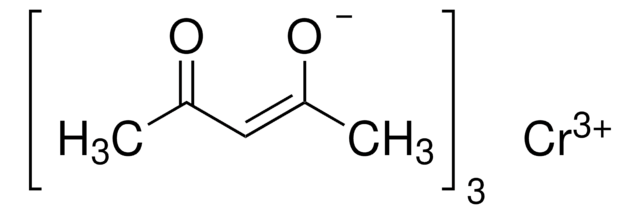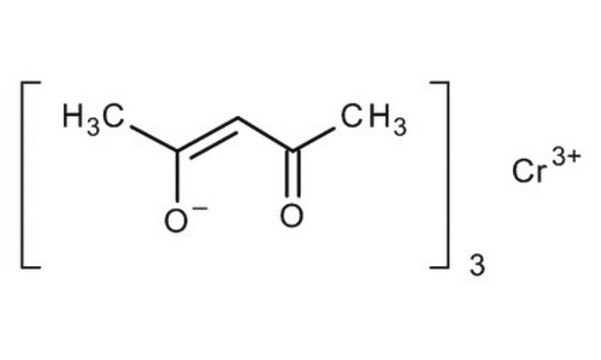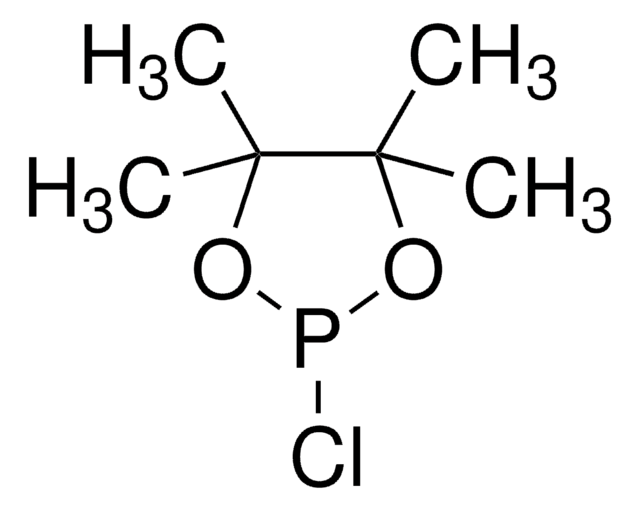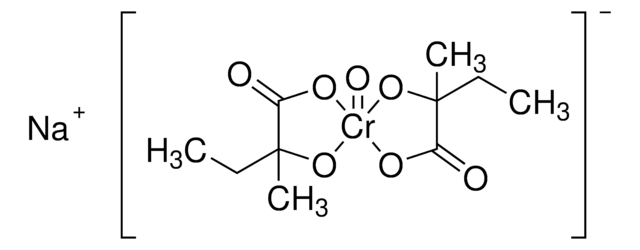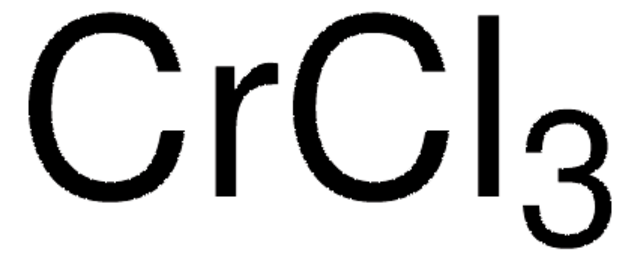574082
Chromium(III) acetylacetonate
99.99% trace metals basis
Synonym(s):
Chromium(III) 2,4-pentanedionate, Cr(acac)3
Sign Into View Organizational & Contract Pricing
All Photos(2)
About This Item
Linear Formula:
Cr(C5H7O2)3
CAS Number:
Molecular Weight:
349.32
Beilstein:
4148971
EC Number:
MDL number:
UNSPSC Code:
12352300
PubChem Substance ID:
NACRES:
NA.23
Recommended Products
Assay
99.99% trace metals basis
form
solid
reaction suitability
core: chromium
bp
340 °C (lit.)
mp
210 °C (lit.)
SMILES string
CC(=O)\C=C(\C)O[Cr](O\C(C)=C/C(C)=O)O\C(C)=C/C(C)=O
InChI
1S/3C5H8O2.Cr/c3*1-4(6)3-5(2)7;/h3*3,6H,1-2H3;/q;;;+3/p-3/b3*4-3-;
InChI key
JWORPXLMBPOPPU-LNTINUHCSA-K
Looking for similar products? Visit Product Comparison Guide
General description
Chromium(III) acetylacetonate is an acidopentamminechromium (111) salt, which is a crystalline material that can be prepared by treatment of precipitated hydrous chromium(III) oxide with acetylacetone.
Application
Chromium(III) acetylacetonate may be used as an active site in the formation of redox systems for the fabrication of flow batteries. It may also be used as a precursor for chromium nitride based metallic coatings.
Analysis Note
Used to modify the surface properties of solid polyurethanes formed in its presence.
Signal Word
Warning
Hazard Statements
Precautionary Statements
Hazard Classifications
Eye Irrit. 2 - Skin Irrit. 2
Storage Class Code
11 - Combustible Solids
WGK
WGK 2
Flash Point(F)
>392.0 °F
Flash Point(C)
> 200 °C
Personal Protective Equipment
dust mask type N95 (US), Eyeshields, Gloves
Choose from one of the most recent versions:
Already Own This Product?
Find documentation for the products that you have recently purchased in the Document Library.
Customers Also Viewed
Chromium (III) acetylacetonate
Fernelius WC, et al.
Inorganic Syntheses, 5, 130-131 (1957)
Yi Wang et al.
Journal of medicinal chemistry, 56(23), 9601-9611 (2013-11-28)
Current precious-metal-containing anticancer agents are mostly chelated with N-containing ligands and function by interacting with DNA. In the present study, Pd(acac)2, a Pd(II) complex containing four O-donor ligands, has been evaluated as an active anticancer agent. Pd(acac)2 showed no interaction
Gong-Jun Chen et al.
Dalton transactions (Cambridge, England : 2003), 39(44), 10637-10643 (2010-10-06)
Two Eu(III) complexes, [Eu(acac)(3)(dpq)] (1) and [Eu(acac)(3)(dppz)] CH(3)OH (2) {viz. acetylacetonate (acac), dipyrido[3,2-d:20,30-f]quinoxaline (dpq), dipyrido[3,2-a:20,30-c] phenazine (dppz)}, have been synthesized and their DNA binding, photo-induced DNA cleavage activity and cell cytotoxicity are studied. The complexes display significant binding propensity to
The direct writing of plasmonic gold nanostructures by electron-beam-induced deposition.
Katja Höflich et al.
Advanced materials (Deerfield Beach, Fla.), 23(22-23), 2657-2661 (2011-05-04)
Channa R De Silva et al.
Journal of the American Chemical Society, 131(18), 6336-6337 (2009-04-17)
Nearly monodisperse lanthanide-doped magnetite nanoparticles were obtained by thermally decomposing a mixture of Fe(acac)(3) and Ln(acac)(3) (acac = acetylacetonate; Ln = Sm, Eu, Gd) in the presence of passivating surfactants. Magnetic studies revealed room-temperature ferromagnetic behaviors of these doped nanoparticles
Our team of scientists has experience in all areas of research including Life Science, Material Science, Chemical Synthesis, Chromatography, Analytical and many others.
Contact Technical Service